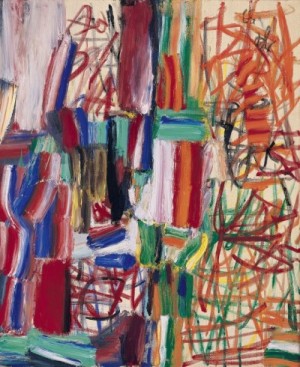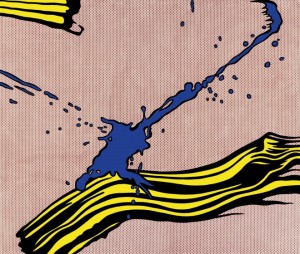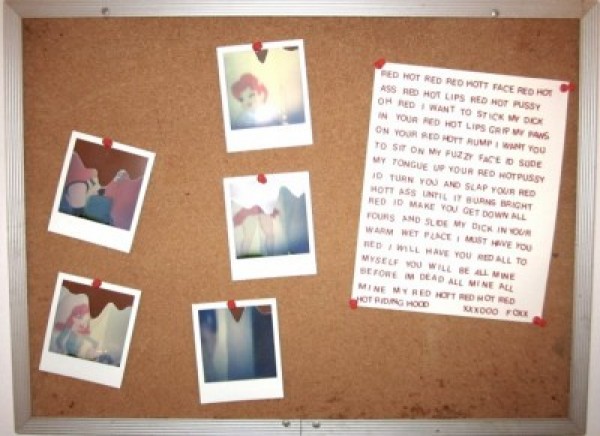
Recently, someone told me they thought Roy Lichtenstein might have been a “one trick pony.” Perhaps that was a prevailing notion prior to the opening of the first major retrospective of the artist since his death in 1997. “Roy Lichtenstein: A Retrospective” at the Art Institute of Chicago involved five plus years in development and contains more than 160 works — drawings, paintings and sculptures. Wandering through the fifteen galleries, you certainly won’t consider Mr. Lichtenstein a “one trick pony.”
Originally entrenched in abstract expressionism, ingrained with his own sense of cubism, the artist began painting his trademark works with “Look Mickey, ” from 1961. Drawing inspiration from the two-dimensional subject matter of comics, Lichtenstein sought to elevate them as a higher art form, focusing on recreating the original mechanical method of production with his own distinctive hand-made process. Capitalizing on the Ben-Day dots native to newsprint, Lichtenstein redirected the energy of the original into more dynamic and streamlined paintings.
Ushering in the Pop Art era in 1961, Lichtenstein became fascinated with all facets of representation in popular culture. Imagery from newspaper or magazine advertisements to comic books, anything harvested from the American consumerist landscape became fodder for the artist. Standouts from this period include “Washing Machine (1961),” “Keds (1961),” “The Ring (Engagement)(1962),” and “Spray (1962)” all capitalize on cropped, enlarged and streamlined images from advertisements. Hot dogs, coffee, buttery toast and several other common household items round out the mix. This style, however, was a minute percentage of the exhibit.

Lichtenstein’s canvases are stripped of color in the adjacent gallery with the “Black and White” series from 1961-1966. Myriad everyday objects take center-stage as the artist plays with notions of scale and subject. Some include trademark Ben-Day dots; most are of varied linear quality — ranging from thin, patterned strokes to heavy angular or curving thick lines or dense geometrically constructed shapes. “Portable Radio (1962)” is humorous in its presentation, as the canvas is equipped with a strap by which it hangs, much like the model it replicates. “The Ring (1962),” “Tire (1962),” and “Golf Ball (1962)” all depict common household items in oversized magnitude, making the curvilinear and geometric forms all the more emphatic. Lichtenstein even finds a way to poke fun at himself with “Magnifying Glass (1963)” in which he examines his own process through the stylized device the canvas is named after.
Moving through the showcase, there is the “War and Romance” series of works that are probably the artist’s most recognizable. “Masterpiece (1962)” once again allows Lichtenstein a little humor at his own expense and “Whaam! (1963)” isn’t to be missed for its explosive (literally) imagery of an American jet fighter in action. The gallery rounds out with several paintings depicting cartoon women obsessing over romantic affairs of one form or another in soap operatic dramatics. When compared to his earliest works, we see the artist’s methods perfected over a slight three-year period. Dot patterns tighten up, lines become crisper and compositions are more harmonious than the inaugural painting, “Look Mickey.”
“Brushstrokes 1965-1971” and “Explosions 1963-1968” both showcase Lichtenstein’s propensity to explore media and approach. He references his former practices in Abstract Expressionism by creating huge scale canvases with bright colored graphic representations of thick impasto brush strokes splayed over Ben-Day black-dot backgrounds. The paintings echo Franz Kline’s abstract large-scale brushwork and Lichtenstein even slips in a direct reference to Jackson Pollock’s drip paintings.

The Explosion series explores several methods of depicting just that — with varying degrees of success. By alternating backgrounds of colored shapes and dot patterns, the impression of explosive force comes across with flying colors. Several works are three-dimensional wall-mountings in which Lichtenstein begins to experiment with material and shadow play. The results are somewhat successful in that he has found many ways to depict the same subject matter, which can be said of the entire exhibit. The real surprises, however, are just around the corner — literally.
Lichtenstein’s later work gets a little help from his friends — and by this, I mean that they are inspired by several other famous artists of the twentieth century and beyond. Not
only does he reference western masters, he draws from eastern traditions as well. Lichtenstein’s very last works will enthuse as much as his earliest — despite the span of his lifelong career, he found ways to keep his style intact.
The last two-thirds of the retrospective is where the formerly thought “one trick pony” truly sheds the moniker. Lichtenstein was apparently not only master of his dots, but, unbeknownst to many, the subject of art history as well. With so much to reveal, the task will be left up to the audience. In detailing the humble beginnings of the show — and Pop Art proper — my hope is to provide a quick guide of Lichtenstein’s famous work, thus allowing a more thought provoking experience for what is less known. The least one could say about the artist is that his reverence in art circles is well-deserved and his exhaustive exploration of medium and subject matter are nearly unmatched.








~ Some Of The Great Artists Lichtenstein Ripped Off ~
Jack Abel
Ross Andru
Martin Branner
Milt Caniff
Hy Eisman
Myron Fass
Dick Giordano
Jerry Grandenetti
Russ Heath
Gil Kane
Jack Kirby
Joe Kubert
Irv Novick
William Overgard
Arthur Peddy
Bruno Premiani
John Romita
Bud Sagendorf
Mike Sekowsky
George Tuska
Deconstructing Roy Lichtenstein © 2000
David Barsalou MFA